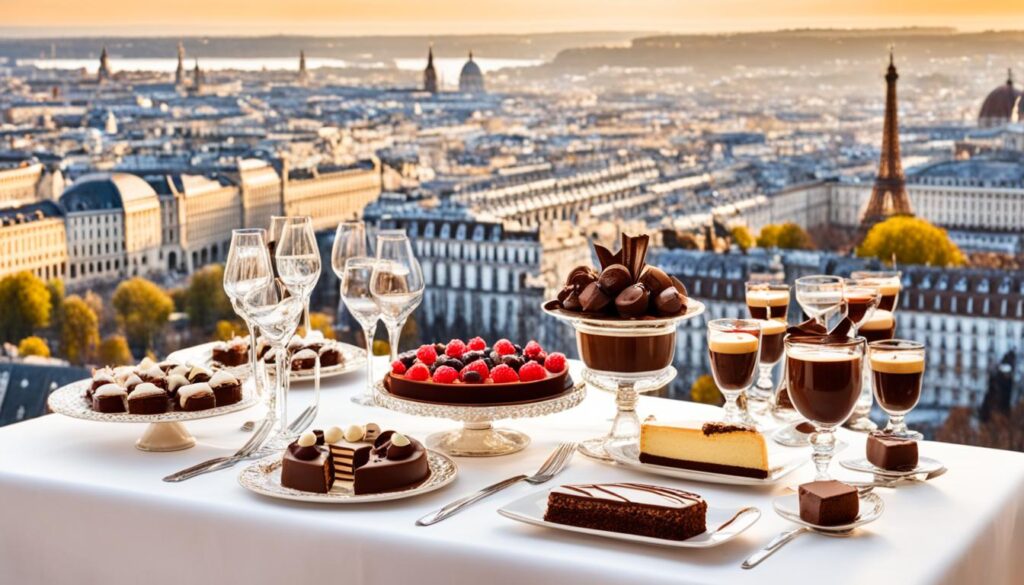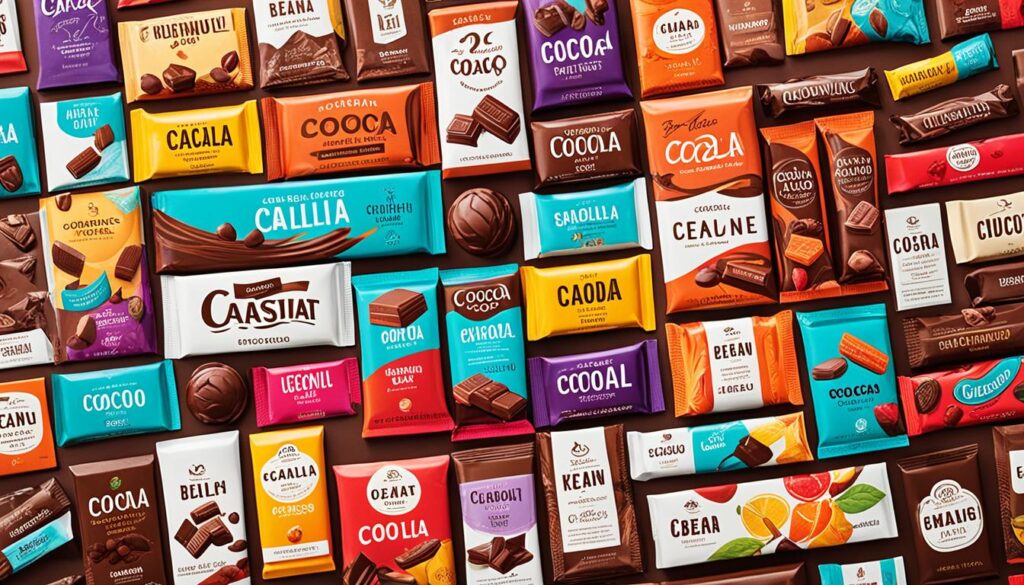Chocolate is a treat that has won over people’s hearts and taste buds worldwide. Its history is long and interesting, starting with ancient Mesoamerican civilizations. It has grown from a simple ingredient to a global favorite.
This article will guide you through chocolate’s evolution. We’ll look at its beginnings, key moments in its development, and its effects on societies and economies. Get ready to learn how a simple cacao bean became a beloved treat around the world.
Origins of Chocolate: Ancient Mesoamerican Civilizations
Chocolate has a long history that goes back to ancient Mesoamerica. Long before Europeans arrived, the Maya and Aztec people valued the cacao bean. They turned it into a sacred drink and a big part of their culture.
The Maya and Their Revered Cacao Bean
The Maya civilization thrived from 250 to 900 AD. They were the first to grow the cacao bean. They saw its value and used it in their religious rituals, economy, and everyday life.
They thought the cacao bean came from the gods. They made a bitter chocolate drink from it. This drink was for sacred ceremonies and the elite.
Aztec Cultivation and Cultural Significance
The Aztec Empire started in the 15th and 16th centuries. They improved how they grew and used the cacao bean. They used it as money and in a spicy chocolate drink for the nobles and priests.
The Aztecs saw the cacao bean as a gift from the god Quetzalcoatl. They used it in religious rituals and ceremonies.
The history of the cacao bean in Mesoamerica set the stage for chocolate’s worldwide popularity. This came after Spanish conquistadors arrived in the 16th century.
Cacao’s Journey Across the Atlantic
The story of chocolate’s move to Europe is tied to the Spanish conquest of Mesoamerica. Spanish Conquistadors entered the Aztec and Maya lands, finding a crop that would change Europe’s food scene: the cacao bean.
Spanish Conquistadors and the Introduction to Europe
In the 16th century, the Spanish conquest of Mesoamerica started a big cultural exchange called the Columbian Exchange. This event changed the region’s politics and society. It also brought new crops and cooking traditions to Europe. The cacao bean was one of these new foods, highly valued by Mesoamerica’s people.
Explorers like Hernán Cortés were amazed by the cacao-based drinks they found. They saw its value and started sending it back to Spain. Soon, it became popular among the European elite.
Chocolate’s arrival in Europe was a turning point. The Spanish nobles loved it, and it spread across the continent. This led to a new era of chocolate enjoyment that changed how we see this treat today.
The Rise of Chocolate Consumption in Europe
In the 16th century, Spanish Conquistadors brought chocolate to Europe. This sweet drink quickly became popular with the upper class. At first, chocolate was rare and only for the elite, seen as a luxury from the New World.
Over time, chocolate became a favorite among people of all social classes. This change was due to better ways of making chocolate and more people having money to buy it. Soon, chocolate was a sign of wealth and good taste among the elite.
Chocolate’s popularity grew thanks to new ways to make it and more people having money. The middle class could now enjoy this tasty treat. Chocolate became a way to show off one’s status and good taste.

Chocolate houses also helped make chocolate popular. These places let people enjoy the drink and talk about important topics. Intellectuals and artists often went there, making chocolate a big part of European culture.
Now, Europe is still a big fan of chocolate. It’s known for its creative chocolate makers and many chocolate traditions. The love for chocolate that started long ago is still going strong, showing how much people love this sweet treat.
Educational: Chocolate’s Transition from Beverage to Solid Form
Chocolate has a long history, starting as a drink in ancient Mesoamerica. It changed from a liquid to a solid food. This change is a story of new technology and growth in the industry. We’ll look at the big steps that made chocolate go from a drink to a favorite treat.
Innovations in Chocolate Processing
The key moment in chocolate’s story was the invention of cocoa pressing. This process took cocoa butter out of the cacao bean. It started in the early 1800s and changed everything. It let people make solid chocolate with a smooth texture we love today.
Then, conching came along. It’s a way to mix and aerate chocolate to make it better. Rodolphe Lindt created it in the late 1800s. Conching made solid chocolate taste and feel better, making it popular with more people.
These new ways of making chocolate, along with tempering, changed everything. Chocolate went from a luxury drink to a common treat. This led to more kinds of chocolate and new ways to make it. Now, we have a wide variety of chocolate products and innovations.
The Industrial Revolution and Mass Production
The 19th century brought big changes to the chocolate industry, thanks to the Industrial Revolution. This era moved from small, hand-made chocolate to large-scale, machine-based production. This change would change how chocolate was made and enjoyed forever.
Mechanization and the Democratization of Chocolate
Entrepreneurs and engineers led this change. They saw how technology could make chocolate production better. Steam-powered machines and special tools made making chocolate faster, more efficient, and cheaper.
This made chocolate available to more people. Richard Cadbury was a key figure in the 1840s. He used new techniques like hydraulic presses and steam grinders to make chocolate smoother and tastier. This made chocolate more affordable for everyone.
Milton Hershey also changed the game in the late 19th century. His company used machines to make chocolate on a huge scale. This made chocolate a common treat in American homes.
The Industrial Revolution had a huge effect on chocolate. It made chocolate a treat for everyone, not just the rich. New ways of making and packaging chocolate helped it become popular worldwide.
Chocolate in the Modern Era
The modern chocolate industry has changed a lot, thanks to globalization and big chocolate brands. Now, chocolate is loved all over the world, not just in Mesoamerica. Its rich flavors and variety have won over hearts everywhere.
Globalization and the Spread of Chocolate Brands
Chocolate has spread far and wide thanks to globalization. Big names like Hershey’s, Nestlé, and Cadbury have reached new markets. They’ve brought chocolate to places where it was once rare.
These brands have grown by using new marketing, good distribution, and knowing what people like. They’ve added everything from classic milk chocolate to fancy dark chocolate and unique artisanal types. This has made chocolate more appealing to everyone around the world.

At the same time, small, independent chocolate makers have appeared. They focus on special tastes, eco-friendly practices, and the story behind chocolate. These companies offer something different from the big brands.
This mix of big and small chocolate makers makes the industry exciting and always changing. It meets the many tastes of consumers and keeps bringing new ideas to the table.
Bean to Bar: The Artisanal Chocolate Movement
Many are now turning away from mass-produced chocolate to enjoy artisanal chocolate. This “bean-to-bar” movement is growing fast. Small producers work hard to bring back the old art of making chocolate. They use high-quality, ethically sourced cacao beans to make delicious chocolates.
The artisanal chocolate movement celebrates the rich history and flavors of cacao. These producers take pride in their work, focusing on single-origin chocolate. They work directly with cacao farmers for sustainable practices that help local communities. This leads to a deeper appreciation for the unique tastes of different chocolate types.
This movement is also about telling stories. Each chocolate bar tells a story of its journey, the producers’ hard work, and the chocolate’s cultural roots. People enjoy the complex flavors and connect with where their chocolate comes from. This focus on being real and open has won over many chocolate lovers.
The artisanal chocolate movement shows that chocolate is more than just a sweet treat. It reflects the people, the land, and traditions behind it. From start to finish, these artisans are changing how we see and enjoy chocolate, one delicious piece at a time.
Ethical and Sustainable Chocolate Production
In recent years, the chocolate industry has focused more on ethical and sustainable practices. Consumers want chocolate made in a way that treats cacao farmers fairly and protects the environment.
Fair Trade and Direct Trade Initiatives
Fair trade and direct trade are changing the chocolate world. Fair trade makes sure cacao farmers get a fair price and better working conditions. Direct trade cuts out middlemen, making the supply chain more transparent and fair.
These efforts have greatly helped cacao farmers. They used to be paid low and treated unfairly. Now, they get a fair price and support for their communities. This has cut down on poverty and improved life in cacao-growing areas.
More people want chocolate that is made ethically and sustainably. Sustainable chocolate aims to protect the environment, like saving rainforests and helping biodiversity. Chocolate makers are also trying to reduce their carbon footprint and use green energy.
As demand for ethical and sustainable chocolate grows, more companies are adopting these practices. This move towards transparency and responsibility could change the chocolate industry. It could make the chocolate world more fair and green for the future of the cacao bean.
Health Benefits and Controversies
Chocolate is a favorite treat, but its health effects are debated. Some say dark chocolate can be good for you. Yet, there are also concerns about eating it.
Chocolate is full of antioxidants, especially dark kinds. These antioxidants can fight off harmful stress and inflammation in the body. Studies suggest that eating chocolate might help with brain function, heart health, and diabetes.
But, there are worries about chocolate’s sugar and fat. Milk and white chocolates often have a lot of sugar, which can lead to weight gain and health problems. There are also debates about how cocoa is grown and the treatment of workers in the chocolate industry.
Despite these issues, scientists keep looking into chocolate’s health benefits. It’s important to eat chocolate in moderation. Think about your diet and health before adding chocolate to it.
The debate on chocolate’s health effects is complex and changing. By being aware and making smart choices, chocolate lovers can enjoy it without worrying too much about its effects on their health.
Regional Chocolate Traditions and Varieties
Chocolate is a treat loved around the world. It has a rich history that spans the globe. There are many regional chocolate traditions and unique flavors to explore.
Let’s dive into the world of regional chocolate varieties. Each region has its own story to tell through chocolate.
Exploring the Diverse Flavors of Chocolate
Ecuadorian chocolate is known for its bold cacao taste. Belgian chocolates are delicate and have floral notes. These are just a few examples of the diverse flavors out there.
In Mexico, Oaxacan chocolate combines cinnamon, almonds, and chili peppers. Swiss chocolate is famous for its smooth texture and subtle flavors. Each region has its own way of making chocolate, shaped by its culture and climate.
Ghanaian chocolate is known for its rich, earthy flavors. Japanese chocolates are delicate and velvety. These chocolates show the creativity and skill of their makers.
Every region’s chocolate tradition is unique. It reflects the local climate, resources, and food culture. This makes chocolate a fascinating treat to explore.






